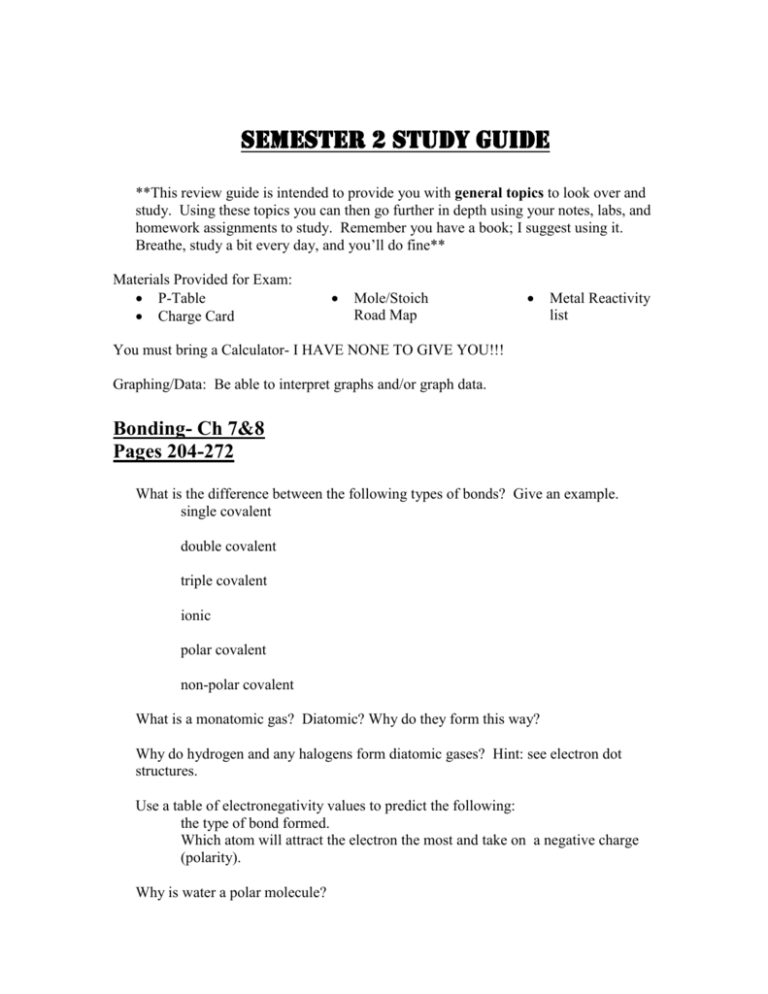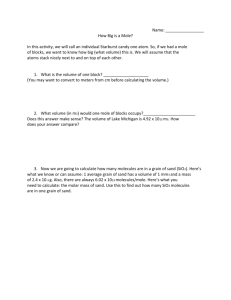Bonding- Ch 7&8 Pages 204-272
advertisement

Semester 2 Study Guide **This review guide is intended to provide you with general topics to look over and study. Using these topics you can then go further in depth using your notes, labs, and homework assignments to study. Remember you have a book; I suggest using it. Breathe, study a bit every day, and you’ll do fine** Materials Provided for Exam: P-Table Charge Card Mole/Stoich Road Map Metal Reactivity list You must bring a Calculator- I HAVE NONE TO GIVE YOU!!! Graphing/Data: Be able to interpret graphs and/or graph data. Bonding- Ch 7&8 Pages 204-272 What is the difference between the following types of bonds? Give an example. single covalent double covalent triple covalent ionic polar covalent non-polar covalent What is a monatomic gas? Diatomic? Why do they form this way? Why do hydrogen and any halogens form diatomic gases? Hint: see electron dot structures. Use a table of electronegativity values to predict the following: the type of bond formed. Which atom will attract the electron the most and take on a negative charge (polarity). Why is water a polar molecule? Know the chemical formulas for the following substances Salt Carbon Dioxide Hydrochloric Acid Ammonia Practice the electron dot structures for the following examples: a. Br2 b. H2O c. NH3 d. O2 e. N2 F. CO2 f. O3 g. C2H6 Chemical Formulas What do the following suffixes indicate and/or when are they used? -ide, -ate, -ite When and why are roman numerals used in some ionic compounds? What does the numeral indicate about the ion? Example: Iron III chloride What is the difference between a subscript and a superscript in a chemical formula? Ca2+(NO3)2How many of each atom are in the above formula? How is the naming system different for ionic vs. molecular compounds? What are the prefixes used for the number 1-10? Practice writing the names or formulas for molecular compounds such as: a. N2O5 b.CCl4 c. boron trichloride d. dinitrogen tetrahydride Explain the significance of the electron in forming compounds and in chemical reaction. Chemical Reactions: Ch 9 pg. 280-310 *Review Labs: Types of Chemical Reactions, Metal Reactivity Lab 1. Write the skeleton equation for the following word equation. Use your charge card to first write correct formula. Balance the skeleton equation. Aluminum sulfate + calcium hydroxide aluminum hydroxide + calcium sulfate 2. What are the five types of chemical reaction we studied. Be able to identify examples of each. 4. Write a balanced equation for the combustion of methane gas, CH4. (When hydrocarbons are combusted, the reactants and products are always the same.) 5. What is the formula for the molecule of diatomic gases such as : a. oxygen d. bromine b. nitrogen e. fluorine c. chlorine Why are these always diatomic? 7. Be able to identify a chemical reaction and predict the products. 8. What is the activity series? Use the activity series to predict the products of a chemical reaction. 9. Rank the following in order of reactivity from lowest to highest Au, K, Ag, Zn, Cu, Al, Ca, Mg The Mole: Ch 10 pg 318-356 Review Sec. 10.1, 10.2 and 10.3 CuSO4 Hydrate Lab Mole Quiz Empirical Formula of Hydrates quiz Homework What is a mole? What quantities are defined by a mole? What is Avogadro’s Number? What does it represent? What is a representative particle? For each of the following, use your mole chart and the periodic table to do the calculation. Show how to set up the problem using dimensional analysis where like units cancel each other out. How many atoms are in 2.5 moles of gold? What is the mass of one mole of Gold? What is the mass of 2.5 moles of gold. What is the volume of 5 moles of O2 gas? What is the volume of 5 moles of He gas? What is the mass of one mole of Lead nitrate? Hint: determine the correct formula with charge card first. How many moles are in 50.0 g of lead nitrate? How many moles are in 100.0 g of CO2 gas? What is the volume of 100.0 g of CO2 gas at STP? Why does the volume of a gas depend on STP (standard temperature and pressure which is 0 deg. C and 1atm pressure) What is the density of Oxygen gas (O2) gas at STP? Remember D= M/V so find the mass of a mole and the volume of a mole of the gas. Sec 10.3 What is the percent composition by mass, of each element in AgNO3 ? What is the empirical formula for the following? a. C8H8 b. N4O6 c. Pb(NO3)2 How is an empirical formula different from a molecular formula? Calculate the empirical formula of a compound that is 62.1% C, 13.8% H, and 24.1% N. Hint: determine the whole number mole ratio from the mass of each element. Show work Chapter 11 Stoichiometry: pg.366-390 Be familiar with the following types of stoichiometry problems: Mass to mass Mass to volume Mass to atoms or particles Mole to mass, volume or particle What is a limiting reactant? Why is it important? How can you calculate the Percent yield? Give formula. What is the actual yield? The theoretical yield? Explain Stoich Problems: 1.) If 5 moles of butane (C4H10) is burned in an excess of oxygen, how many moles of carbon dioxide will be formed? 2.) Magnesium reacts with silver (I) nitrate in a single displacement reaction. What mass of silver is formed when 2.43 grams of magnesium are used? 3.) Potassium chlorate decomposes to form potassium chloride and oxygen. If 0.0200 moles of KCl are produced, what mass of KClO3 was used? 4.) Freon-12 (CCl2F2) is used as coolant in refrigerators is formed in the following reaction: 3 CCl4 + 2 SbF3 3 CCl2F2 + 2 SbCl3. If 150 grams of monocarbon tetrachloride are used, how many liters of freon are formed? 5.) Using the information in number 4, what if 100 grams of SbF3 where used? Would you still make the same quantity of freon? How many liters in this case? (Hint: Think about which is the limiting reagant.) 6.) Zinc reacts with hydrochloric acid in a single displacement reaction. If 40 ml of hydrochloric acid (HCl) are used, how many moles of zinc can react? (assume HCl has a density of 1.1 g/ml) Limiting Reagent: Arcylonitrile, C3H3N, is the starting material for the production of a kind of synthetic fiber acrylics) and can be made from propylene, C3H6, by reaction with nitric oxide, NO, as follows: 4 C3H6 (g) + 6 NO (g) → 4 C3H3N (s) + 6 H2O (l) + N2 (g) What mass of C3H3N can be made when 21.6 g of C3H6 react with 21.6 g of nitric oxide? Hint find Limiting Reagent first!






